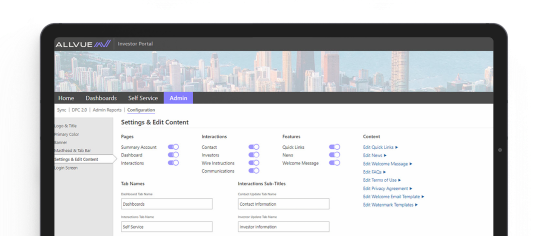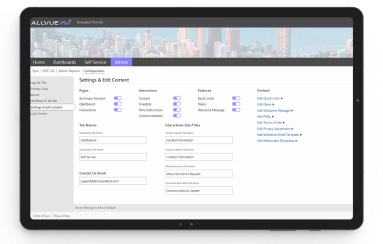
By: Michelle Wu
Head of Marketing
April 24, 2025
Asset allocators are tasked with the role of helping investors strategically distribute their investments across various asset classes — such as stocks, real estate, credit, and private equity — in a way that maximizes returns while minimizing risk.
Each of these asset classes presents unique characteristics, risks, and potential rewards. Take private equity for instance. It holds the potential for high returns and access to innovative opportunities not yet available in public markets. But it also comes with several risks and challenges, including illiquidity and long investment horizons. Making good allocation decisions for this asset demands a deep understanding of the alternatives market and such complexities.
To optimize private equity allocations, many asset allocators are adopting data-driven strategies. In this article, we’ll outline how asset allocators are leveraging data to make smarter private allocation decisions and drive better outcomes for their clients.
Who are asset allocators?
Asset allocators are organizations that help investors divide their capital or portfolio into different asset classes such as equities, fixed income, real estate, and alternative investments like private equity and venture.
Examples of asset allocators are pension funds, endowments, sovereign wealth funds, and insurance companies. Their primary goal is to construct diversified portfolios that balance risk and return.
Why allocate to private equity?
Private equity is usually a key component of asset allocation for several reasons.
First, this asset class offers the potential for high returns through its ability to capitalize on undervalued or growth-focused opportunities. In fact, data shows that private equity has historically outperformed public markets over the long term.
Secondly, private equity offers exposure to investments that are less correlated with public markets. This reduces overall portfolio volatility and provides a hedge against market downturns.
In addition, allocating to private equity grants investors access to innovative companies, niche markets, and transformative industries that are typically unavailable in public markets. These opportunities can drive portfolio growth while also providing exposure to emerging trends and cutting-edge technologies and supporting broader strategic objectives such as environmental, social, and governance (ESG) or sustainability.
Finally, private equity investments typically involve longer holding periods, which align well with the goals of most institutional investors such as pension funds, that prioritize building long-term wealth for their investors.
However, asset allocators must be very cautious when allocating to private equity. Poor allocation decisions can introduce unnecessary risks or fail to capitalize on market opportunities. This is where data-driven approaches come into play.
Data enables asset allocators to optimize their strategies and make allocation decisions with greater confidence and precision. In the next section, we’ll dive into this further telling you the exact benefits that asset allocators stand to gain by leveraging data.
Benefits of data-driven private equity allocation
Informed allocation decision
Data analytics provide a detailed understanding of how private equity fits within the broader portfolio. For example, by analyzing the historical performance, risk-adjusted returns, and the general market trends of private equity, asset allocators can determine the optimal percentage to allocate to this sector relative to other asset classes such as equity.
Once they’ve decided on the specific amount to allocate to private equity, data can further help asset allocators make informed decisions on which private equity strategies — such as buyouts, venture capital, or growth equity — to pursue for the best possible returns, and how much to allocate to each.
Furthermore, data can help asset allocators select the funds and managers that best align with their investment strategy and long-term goal, or that are likely to deliver the strongest returns.
Risk mitigation and diversification
Private equity investments are inherently riskier due to their illiquid nature and long-term horizons. Data-driven approaches can help allocators mitigate these risks while building more resilient portfolios.
Using data, allocators can evaluate the risk-return profiles of different private equity stages, from early-stage venture capital to later-stage buyouts or distressed asset acquisitions. This insight enables them to construct portfolios that balance high-growth, high-risk investments with stable, income-generating options.
Advanced data-driven models allow for scenario analysis and stress testing, simulating how a portfolio would perform under different market conditions. These tools help allocators understand potential risks and the impact of adverse events, such as economic downturns or interest rate hikes. With these insights, they can design allocation strategies that are more resilient to market shocks.
Data can also help asset allocators identify complementary managers or funds whose approaches differ, ensuring that the portfolio does not overly rely on a single investment philosophy or sector focus.
Continuous monitoring and adjusting the allocation
Data-driven approaches allow asset allocators to continuously monitor the performance of the portfolio. Real-time data can highlight shifts in performance, changing market conditions, or potential risks. Asset allocators can then use this info to adjust their private equity allocation as needed.
For instance, if a certain fund underperforms or market conditions shift, asset allocators can adjust allocations as necessary to maintain the desired risk-return profile of the overall portfolio.
Key metrics and tools for data-driven private equity allocation
Data-driven private equity allocation requires asset allocators to analyze key metrics and leverage advanced tools to make informed decisions. These metrics and tools enable allocators to optimize portfolio composition, mitigate risks, and align private equity investments with broader objectives.
Below are some essential metrics and tools that support effective allocation strategies.
Metrics
- Public Market Equivalent (PME): PME compares the performance of a private equity investment to a comparable public market benchmark. This can assist with allocation decisions at the portfolio level — i.e. with determining how much to allocate to private equity vs public markets.
- Internal Rate of Return (IRR): Measures the annualized return of private equity funds over a specific investment period. IRR helps allocators evaluate the performance of private equity funds over time and compare opportunities across different managers.
- Multiple on Invested Capital (MOIC): Tracks the total value generated by a fund compared to the capital invested. Allocators use this metric to assess a fund’s efficiency in creating value.
- Distributed to Paid-In (DPI): Reflects the amount of capital returned to investors as a proportion of their total capital contributions. DPI provides a clear picture of realized gains and is critical for evaluating a fund’s cash flow performance.
Each of these metrics plays a vital role in understanding the performance and potential of private equity investments. They provide allocators with a data-driven foundation for decision-making.
Tools and platforms for data analytics
To effectively analyze these metrics and make data-driven decisions, asset allocators can leverage a variety of tools and platforms:
Private equity databases
These are comprehensive repositories of data on private equity funds, managers, and investments. They provide access to critical information like fund performance data (IRR, TVPI, DPI), manager biographies, investment strategies (like venture capital, buyout, growth equity), portfolio holdings, industry trends, and much more.
Many private equity databases include powerful search and filtering functionalities that allow users (i.e. asset allocators) to easily find and analyze data based on specific criteria, such as fund size, investment strategy, and manager characteristic experience. They also provide access to industry benchmarks and peer comparisons to evaluate fund performance relative to industry standards.
Asset allocators can leverage private equity databases to conduct in-depth research on the private equity market in general, and to compare the performance of different private equity funds or managers.
Example: Preqin, PitchBook
Portfolio management software
These are specialized software solutions designed to help asset allocators track and manage their private equity investments. Some of the primary features of private equity are:
- Portfolio tracking: Track investments across multiple funds and managers, including activities such as capital calls, distributions, and valuations.
- Performance analysis: Calculate and track key performance metrics, such as IRR, TVPI, and DPI.
- Risk management: Assess and monitor portfolio risk, including concentration risk, liquidity risk, and currency risk.
- Investor reporting: Generate customized reports for investors, including performance reports, portfolio updates, and other relevant information.
- Workflow automation: Automate various tasks, such as data entry, reporting, and investor communications.
Example: Allvue Systems portfolio management software.
Best practices for data-driven private equity allocation
Incorporate diverse data sets
Gather and integrate a wide range of data sources, such as market research, financial statements, transaction data, industry reports, and economic indicators, and even alternative data such as social media sentiment and satellite imagery.
A broader range of data sources or types of data provides a more holistic and comprehensive understanding of the private equity investment landscape and can uncover hidden opportunities and risks. It can help you make more informed decisions overall.
Build a solid data infrastructure
Establish a centralized repository to collect, store, and manage all relevant investment data from various sources. Next, implement robust data quality controls, including data validation, cleansing, and reconciliation processes, to ensure the accuracy and reliability of all data sources.
Leverage advanced data analytics tools
Use advanced tools and technologies to conduct high-level data analysis and extract more meaningful insights from it. For example, artificial intelligence (AI) and machine learning (ML) technologies can process vast amounts of data in a short time and identify patterns, trends and risks that other methods might miss.
Foster a data-driven culture in your organization
Educate investment professionals in your organization or decision-makers on the importance of data analysis, the effective use of data-driven tools, and the interpretation of data insights. Foster a culture where data-driven insights are valued and integrated into all aspects of the allocation processes.
Continuously monitor and adapt
Treat data-driven private equity allocation as an ongoing process rather than a one-time activity. Regularly evaluate key performance indicators such as IRR, TVPI, and DPI to assess whether allocations are meeting expectations and make adjustments as necessary. Continuously refine data collection, analysis, and interpretation methods to make even better allocation decisions with time.
Challenges in data-driven private equity allocation
While data-driven approaches offer significant advantages to asset allocators as we’ve seen, several challenges can hinder their effective implementation:
Data gaps and inconsistencies
A significant challenge in data-driven private equity allocation is the presence of data gaps and inconsistencies. Asset allocators often rely on data from private equity funds, managers, and third parties, which may be incomplete or inconsistent. This lack of reliable data can hinder effective decision-making and risk assessment. To address this, firms need to invest in robust data collection and management solutions that have the ability to integrate and standardize data from various sources.
Human factors
A lack of data literacy among asset allocation professionals can hinder the effective utilization of data-driven insights. Some investment professionals may also be resistant to adopting new technologies and embracing data-driven approaches. Confirmation bias and other cognitive biases can influence how investment professionals interpret data and make decisions.
To address these human factors, asset allocators can implement several strategies including:
- Investing in continuous education programs to enhance data literacy among professionals.
- Promoting a culture that embraces new technologies and data-driven decision-making.
- Conducting workshops to raise awareness of cognitive biases and their impact on decision-making.
Regulatory and compliance issues
Asset allocators must navigate complex regulatory and compliance requirements, which can vary across jurisdictions. These regulations can impact data collection, storage, and analysis practices. Non-compliance can lead to legal issues and financial penalties. To mitigate these risks, organizations should stay informed about relevant regulations, implement investment compliance checks within their data management processes, and invest in technologies that support compliance requirements.
Technological barriers
Another challenge is the technological barriers that prevent asset allocators from fully adopting data-driven strategies. Some organizations operate on legacy systems that are not equipped to handle the demands of modern data analytics. To overcome these barriers, firms should consider investing in modern data analytics platforms that offer scalability, flexibility, and integration capabilities.
Wrapping up
Data-driven strategies are helping asset allocators navigate the complexities of asset allocation more effectively. With regard to private equity, data is empowering allocators to make more informed decisions about capital distribution. For example, by analyzing performance metrics, market trends, and risk factors, allocators can identify which private equity opportunities to pursue, and which funds and managers to partner with for the best possible returns.
As private equity continues to expand as a critical asset class, the role of data in optimizing allocation decisions will only grow
Allvue Systems’ private equity software is designed to help you fully unlock the power of data in asset allocation. With cutting-edge tools for tracking investments, assessing portfolio performance, and managing risk, Allvue provides the data insights needed to make smarter, more strategic allocation decisions.
Discover how Allvue can optimize your private equity allocation strategies by requesting a free demo today.
Sources
KKR. Can Private Equity Continue to Produce Excess Returns Above What Is Available in the Public Markets? https://www.kkr.com/insights/private-equity-vs-public-market-returns
More About The Author

Michelle Wu
Head of Marketing
Michelle is a dynamic marketing leader with 15+ years of experience in capital markets, fintech, and cybersecurity technology industries. Prior to joining Allvue, Michelle was the Vice President of Product Marketing at SecurityScorecard, a global leader in cybersecurity ratings, and was the Head of Security & Compliance Marketing at Box. Before moving into cybersecurity, she led the Banking & Securities GTM strategy at Intralinks and covered capital markets clients at HSBC. She holds an MSc in Media & Communications from the London School of Economics and a BS in Marketing & Finance from NYU Stern School of Business.


